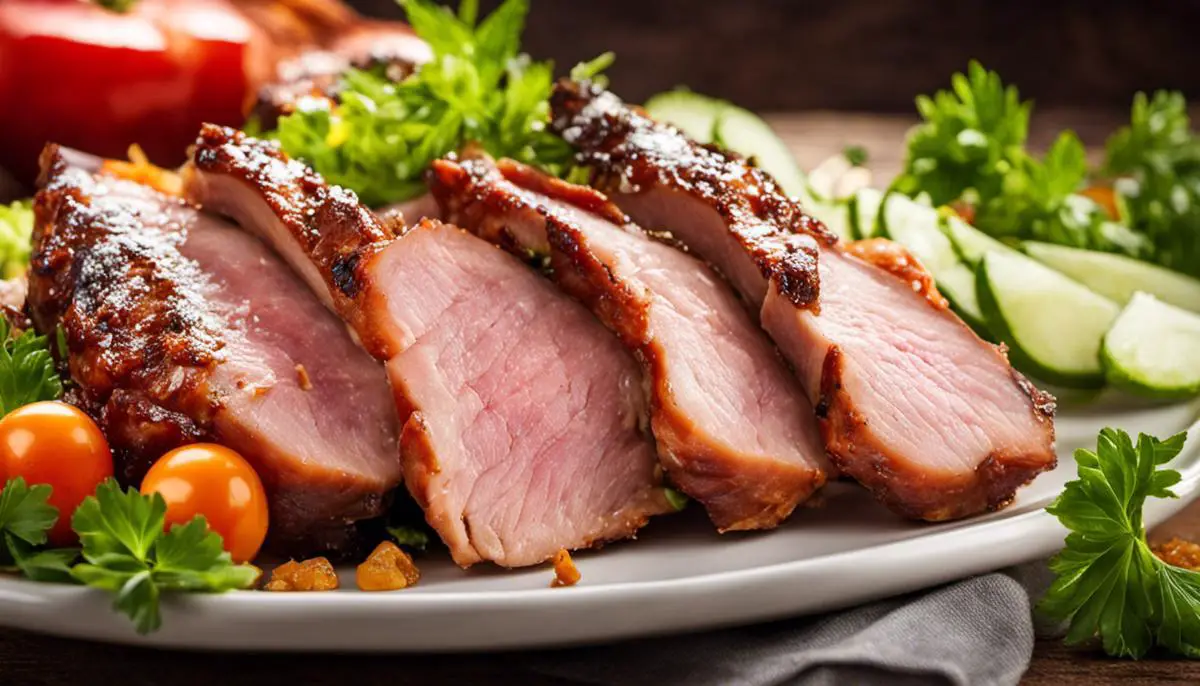The diet and nutrition of an individual fundamentally determine the health and lifestyle they lead. More than just sustenance for survival, dietary choices can stifle or stimulate the inverse correlation between disease and wellbeing. One such choice we delve into is that of pork consumption.

This piece explores the nutrient profile of pork, contrasting it with other commonly consumed meats, to understand its dietary relevance and potential health outcomes. Additionally, the influence of farming practices on the nutritional worth of pork, the nutritive changes brought about by various culinary approaches, and its role in sustainable diets are investigated. The intent is to provide a comprehensive understanding of the impact of pigs on our diet and nutrition.
Diet and Nutritional Profile of Pork
Nutritional Content of Pork
Pork, also known as pig meat, is a rich source of high-quality protein with various cuts and preparations offering various levels of nutritional attributes. To illustrate, a three-ounce cooked serving of pork loin, a popular cut, contains 22 grams of protein. This protein content is essential for building and maintaining body tissues, producing antibodies for a healthy immune system, and fostering growth and development in children and adolescents.

Pork Fat Types
Pork consists of both saturated and unsaturated fats. Depending on the cut and preparation, the specific fat content varies. Lean cuts such as pork tenderloin have less total fat and saturated fat compared to fattier cuts like pork belly. Consuming saturated fats in moderation aligns with a balanced diet, as they can increase cholesterol levels and potentially lead to heart disease when overly consumed. Alternately, unsaturated fats can help lower bad cholesterol levels when consumed in lieu of saturated fats, which can reduce heart disease risk.
Vitamins and Minerals in Pork
Among vitamins, pork shines in terms of thiamine (Vitamin B1) content. Thiamine is crucial for carbohydrate metabolism and supports nerve function, brain development, and the production of DNA and RNA, our genetic material. In addition, pork is a good source of niacin, vitamin B6, and vitamin B12, playing vital roles in brain function and overall wellbeing. Among minerals, selenium and zinc are abundant in pork. Selenium is important for cognitive function and boosting immunity, while zinc aids in wound healing, protein synthesis and supports a healthy immune system.
Comparison with other Meats
In comparison to other meats such as chicken and beef, pork’s nutritional profile holds its ground. While chicken has less total fat than pork, pork contains fewer calories per serving. Similarly, certain cuts of pork like the tenderloin have less saturated fat than a skinless chicken breast. This makes pork a reasonable choice for those monitoring their caloric or saturated fat intake. Moreover, when compared to beef, pork stands out for its higher thiamine levels, making it a superior source of this important nutrient.
Impact on Health, Diet, and Nutrition
Including pork in a balanced diet can support good health when consumed in moderation and when lean cuts are chosen. Its high-quality protein and array of vitamins and minerals contribute greatly to daily nutritional needs. However, consuming processed pork products like bacon and sausage should be limited, as these often contain high amounts of sodium and can be higher in saturated fats. As with any food, moderation and preparation methods are key to ensuring consumption supports overall health.
Benefits and Suggestions for Pork Consumption
Individuals seeking to augment their protein intake might consider incorporating pork into their dietary plan. Pork, being rich in thiamine, also supports a robust nervous system and promotes brain health. When consuming pork, it’s advisable to select lean cuts and employ healthier cooking methods such as grilling, broiling, or roasting to limit additional calorie and fat intake. To maximize the nutritious value of pork, pairing it with a range of vegetables and whole grains is recommended.

Farming Practices & Its Effect on Diet and Nutrition
Influence of Swine Diet on Pork’s Nutritional Quality
Recognizing the impact of pig farming practices on the nutritional profile of pork necessitates a deep understanding of the pigs’ diet. Generally, pigs are raised on a diet dominant in grains, primarily encompassing corn, wheat, and soybean meal, geared at fostering their growth and weight gain. However, the nutritional composition of these feeds can differ significantly, leading to inconsistencies in the meat’s nutritional value.
In addition, pig feed might be supplemented with additives including amino acids, vitamins, and minerals, which could enhance the nutrient content in the meat. As consumer consciousness about health and food safety rises, some farmers are gravitating towards feed free of antibiotics and synthetic enhancers, theorizing that organic feeds could potentially yield a more nutritious meat with a lower likelihood of harmful residues.
Antibiotic Usage in Pig Farming
Another significant aspect that affects the nutritional quality of pig meat is the use of antibiotics. The practice of administering antibiotics to pigs serves two primary purposes: promoting growth and preventing or treating diseases. While the growth-promoting aspect has been phased out in many parts of the globe due to concerns about antibiotic resistance, its use for disease prevention and treatment is still prevalent.
Antibiotics used in animal farming have been tied to traces of antibiotic-resistant bacteria found in meat, which could pose a health risk to humans. Although the direct impact of these traces on the nutritional value of the meat is hard to assess, it’s part of a wider issue concerning the safety and overall quality of our food supply.
Farming Conditions and Meat Quality
The conditions in which pigs are farmed can significantly impact the nutritional profile of the meat. For instance, pigs reared in crowded and stressful environments tend to have higher levels of stress hormones, which can affect the meat’s quality and taste. Moreover, such conditions can promote the spread of diseases, leading to increased use of antibiotics.
On the other hand, pigs that are free-ranging or raised in more humane conditions tend to produce meat of superior quality. That’s because these pigs have the opportunity to exercise and therefore develop more lean muscle, leading to meat with less fat and higher protein content.
Genetic Factors
Modern pig farming also involves selective breeding techniques to improve feed conversion efficiency and overall meat production. This has resulted in pigs that grow larger and faster, but it also affects the quality and nutritional properties of the meat. Generally, selectively bred pigs tend to have more fat, less muscle, and consequently, carry higher calorie content per serving.
Culinary Uses of Pork and Nutritional Impact
Pork: A Protein-Rich and Versatile Meat
Recognized for its versatility, pork can be cooked using various methods like roasting, grilling, frying or slow-cooking. Its unique taste makes it a popular choice in many international dishes. Beyond its taste, pork provides an excellent source of protein, and variety of vitamins and minerals essential for maintaining a balanced diet.

Culinary Uses of Pork and Their Nutritional Implications
The method of pork preparation significantly impacts the nutritional value of the resultant dish. For example, lean cuts of pork like tenderloins or loin roasts, when grilled or roasted, retain most of their nutritional value and can be a part of a balanced, protein-rich diet. Conversely, deep-frying or overly processed pork products can add saturated fats, salts, and nitrates, which may have implications for heart health if consumed excessively.
Pork in Global Diet and Nutrition
Pork plays a prominent role in a variety of cultural diets. In many Asian cuisines, pork is a protein staple, featured in dishes like dumplings or noodle stir-fries. Meanwhile, in Western cuisines, pork could be found in forms like bacon, ham, or ribs. While these forms can often be higher in sodium and fat than plain cuts, consuming them in moderation as a part of varied diet can enable one to enjoy their flavors while maintaining balanced nutrition.
Balancing Consumption for a Healthy Diet and Nutrition
While pork can play a significant role in a balanced diet, it’s essential to consider the nutritional variations among different parts of the pig and how it’s prepared. Lean parts of the pig, like loin or tenderloin, provide plenty of protein without the associated high fat content found in cuts like belly or shoulder. Furthermore, limiting consumption of overly processed forms like cured hams and sausages, which can be high in sodium and nitrates, can help balance the benefits of pork consumption with potential health risks. Making informed choices about the type and preparation of pork can thus play a significant part in nutrition and overall health.
The Role of Pork in Sustainable Diet and Nutrition
When examining food’s impact on our environment, pork production comes into consideration. Like any form of livestock farming, raising pigs for meat requires extensive utilization of natural resources and produces a significant amount of greenhouse gas emissions. Those aiming for more sustainable eating habits might consider balancing the consumption of pork with plant-based protein sources such as legumes and pulses. Also, selecting pork from farms that emphasize sustainable production practices could reduce the overall environmental footprint.

Pork and Sustainable Diet and Nutrition
A Deeper Look at Pork’s Environmental Impact
Pork serves as a primary source of animal protein worldwide, especially in regions like Asia, Europe, and North America. Despite its popularity, it’s essential to understand the environmental issues related to pork production and pig farming which include greenhouse gas emissions, deforestation, and nutrient pollution from manure. Pig farming specifically accounts for around 9% of total livestock-linked greenhouse gas emissions globally.
However, a contrast exists when comparing pork with beef and lamb; pigs require fewer resources and produce lower greenhouse gas emissions per kilogram of meat. The adoption of technological advancements, enhancement of feed conversion efficiency, and better manure management practices hold the potential to decrease pig farming’s environmental footprint further.
Pigs, Ethics, and Food Security
Ethically, the rearing and slaughtering of pigs for pork presents legitimate concerns. Intensive pig farming practices characterized by restrictive housing conditions, routine mutilations, and high-stress environments draw criticism from animal rights groups. Conversely, free-range or organic farming methods while costly, provide better living conditions for the pigs. These methods, though, are not as economically efficient as intensive farming, making pork more expensive and potentially less accessible to low-income consumers.
Pigs do contribute significantly to food security. They convert food unfit or unsavory for human consumption into high-quality protein. Their short reproductive cycle enables quick ramp-up of production in response to predicted food shortages.
Eating Nose to Tail
The concept of ‘nose to tail’ eating involves consuming all parts of the pig – from hocks and trotters, to cheeks and organs instead of focusing just on prime cuts like loin and ham. This practice reduces food waste and promotes a sustainable food system. It also helps in maximizing the nutritional potential of the pig. Organ meats, for instance, are nutrient-dense sources of vitamins, minerals, and amino acids often lacking in muscle meats.
Summary
While there are environmental and ethical challenges that need to be addressed, pigs contribute to food security and could potentially enrich our diets. ‘Nose-to-tail’ eating represents a holistic approach to consumption that promotes sustainability and nutrition. It encourages respectful utilization of the animal and ensures no valuable part goes to waste.
Pork, consumed in moderation, can provide a wealth of nutrients, with the exact profile being subject to farming practices and culinary preparations. Furthermore, pigs play a pivotal role in the context of sustainable diets, as utilizing the whole animal reduces waste and supports food security. Yet, it’s important to be mindful of potential ethical and environmental considerations intrinsic to pork production.
All of these dimensions add layers of complexity to the decision to include or exclude pork from one’s diet— a choice that goes beyond taste or tradition, transcending into the realms of health, ethics, and sustainability. Thus, an informed perspective, such as presented in this discourse on the matter, can facilitate healthier, sustainable, and conscientious dietary choices.